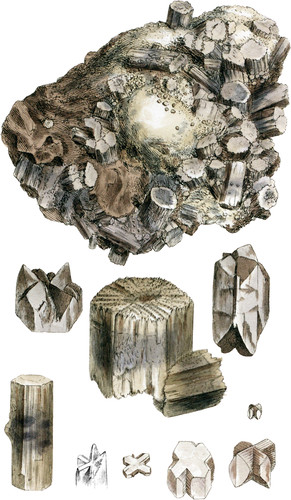 Enlarge
Enlarge
Exotic Mineralogy
Arragonite
- Syn. Arragonite.
- Haüy, Traité 4. 337. Tabl. 6.
- Bournon Traité de la Chaux carbonatée 2. 119.
The varieties of Arragonite, figured in British Mineralogy, tab. 147, are externally very different in appearance from that one from which the species derives its name, and which I here figure: the crystals are hexahedral prisms produced by the grouping of several tetrahedral ones: two varieties of these have been fully explained by the Count de Bournon, in his elaborate work upon Carbonate of Lime. The small crossed crystals I have shown at the bottom of the plate, some of which are selected from the Count’s collection, partly illustrate the most common kind of compounded hexahedral prisms, having four angles of 117° 2′ and the other two of 125° 56′. The Count’s explanation of these corresponds nearly with that given by Haüy : it is very probable that there are several other prisms produced by various arrangements of the rhomboidal prisms. Haüy describes one composed of four, according to him it has three angles of 128° (125° 56′ of Bournon) two of 116° (corresponding with the obtuse angles of the primitive or 117° 2′ of Bournon) and one differing from all the others, being 104°. Bournon describes one composed of three primitive prisms, modified so as to meet together and produce three angles of 122° 58′, leaving the other three primitive or 117° 2′: this cannot be referred to Haüy′s, but I conceive that if angles taken from the concave faces of which these aggregates are composed, could be relied upon, several other compounds would be found. I have given a rough sketch of a white one composed of five very irregularly arranged, but yet producing an hexahedral prism, tolerably neat for a part of its length: this is taken from among a number of others upon a matrix of common Carbonate of Lime, with Grey Silver, Galæna, and Copper pyrites, from the Leogang, Salzburgh, in the Tyrol. The other specimens are from Molina, in the kingdom of Arragon, Spain, where the substance is abundant, imbedded in Clay, and frequently attached to masses of amorphous Gypsum: minute opaque red crystals of Quartz are often partly imbedded in the crystals of Arragonite. The three upper specimens are from Mr. Heüland’s, late Mr. Forster’s, splendid collection.
Since his Traité de Mineralogie, Haüy has considered a rectangular octohedron (three such compose the middle right hand figure) two of whose faces meet over the base at 115° 56′ and two others at 109° 28′ (the terminal ones in the figure) as the primitive: but Bournon thinks it to be a prism of 117° 2′, differing 1° 6′ from two of the faces of Haüy’s primitive and parallel to which indications of laminæ; often occur; but the other faces of the octohedron he considers secondary.
| Carbonate of Lime | 94.5757 |
| Carbonate of Strontian | 3.9662 |
| Hydrate of Iron | 0.7060 |
| Water of crystallization | 0.3000 |
| 99.5479 |

